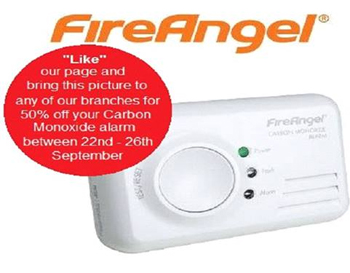
It is Carbon Monoxide Awareness Week and with the introduction of new building regulations governing heat producing appliances on Sept 1st, all installers must become informed about their obligations which includes the mandatory installation of CO detectors.
FireAngel CO detectors are now available in all Hevac branches with an exclusive offer of 50% off during Carbon Monoxide awareness week..
In addition installers must ensure there must be adequate air supply to all appliances for combustion and for efficient working of flues and chimneys. There must be adequate discharge of combustion products to the outside air. Flue pipes, fireplaces and chimneys must be designed and constructed as to reduce the risk of the building catching fire. Oil storage tanks must be located so as to minimise risk of fire spreading from a building to the tank.
What is Carbon Monoxide (CO)
Carbon Monoxide (also known as CO) is a colourless, odourless poisonous gas and is a common yet preventable cause of death from poisoning worldwide. Approximately half of the deaths from unintentional CO poisonings result from the inhalation of smoke from fires. Other significant causes are vehicle exhausts and deaths in industrial / commercial settings. On average between 1 and 2 people die each year in Ireland from unintentional CO poisoning in the home in incidents related to domestic heating or other fossil fuel installations in the home (i.e. excluding the inhalation of smoke from fires).
The incomplete combustion of organic fossil fuels such as oil, gas or coal is a common environmental source of CO and is responsible for many cases of non-fatal unintentional CO poisoning.
In normal conditions the combustion process (the addition of oxygen) will result in carbon in the fossil fuel, combining with oxygen, in the air, to produce Carbon Dioxide (CO2), the same substance we exhale when we breathe.
However, if there is a lack of air for the combustion process or the heating appliance is faulty, Carbon Monoxide can be produced.
When CO is inhaled into the body it combines with the blood, preventing it from absorbing oxygen. If a person is exposed to CO over a period, it can cause illness and even death.
Carbon Monoxide has no smell, taste or colour. This is why it is sometimes called the "Silent Killer".
Carbon Monoxide alarms can be used as a backup to provide a warning to householders in the event of a dangerous build up of CO. Check that the Carbon Monoxide alarm complies with the EN 50291 standard. Remember that Carbon Monoxide alarms are no substitute for regular inspection and maintenance of appliances, vents, flues and chimneys.
Please "LIKE" our facebook page